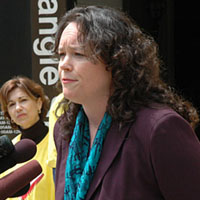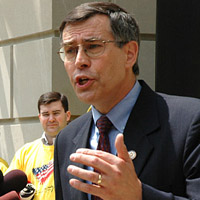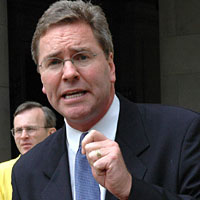 |
 |
 |
| Linda Schade, TrueVoteMD.org >> | Rep. Rush Holt (D-NJ) >> | California
Secretary of
State Kevin Shelley >> |
|
|||
| Posted May 7, 2004. The Election Assistance Commission (EAC) is a four member commission established by the Help America Vote Act of 2002 (HAVA) to "serve as a national clearinghouse and resource for the compilation of information and review of procedures with respect to the administration of Federal elections." The EAC began its formal activity in mid-February, and on May 5 it held its first public hearing, examining the status of computerized electronic voting systems. Outside, several dozen activists held a press conference to express their concerns about electronic voting. Fair Election |
 |
 |
 |
| Linda Schade, TrueVoteMD.org >> | Rep. Rush Holt (D-NJ) >> | California
Secretary of
State Kevin Shelley >> |
| Among those addressing the group were:
-Avi Rubin, professor of computer science at Johns Hopkins University, who in a July 2003 report on a version of Diebold's AccuVote-TS voting terminal found "significant and wide-reaching security vulnerabilities." -Linda Schade, a founder of the Campaign for Verifiable Voting (TrueVoteMD.org), who on April 22, 2004 filed a lawsuit against the Maryland State Board of Elections and its Administrator charging them with "improperly certifying the Diebold AccuVote TS electronic voting machines used in Maryland, and then failing to either correct or decertify the machines..." Schade said the systems were "really not ready for deployment" and described vendors and some elected officials as "aggressively disinterested in facts." -Congressman Rush Holt (D-NJ), who in May 2003 introduced the Voter Confidence and Accessibility Act, H.R. 2239. Among its provisions, the bill would require voting systems to "produce a voter-verified paper record suitable for a manual audit equivalent or superior to that of a paper ballot box system." (Sen. Bob Graham has introduced a parallel bill in the Senate, S. 1980). -California Secretary of State Kevin Shelley, who on April 30, 2004 took the extraordinary measure of decertifying the Diebold TSx system used in four counties and requiring additional security measures or a voter verified paper trail be implemented for 10 additional counties using touchscreen systems. Shelley said that a year ago he thought the worries about electronic voting were "computer geeks having their way in the media." However, he was galvanized into action after an April 20 staff report found that, "Diebold marketed, sold, and installed its TSx in these four California counties prior to full testing, prior to federal qualification, and without complying with the state certification requirements" and that the company engaged in "overly aggressive marketing." Shelley has gone so far as to refer the matter to the Attorney General, suggesting "fraudulent actions by Diebold." TrueMajority, an online organization, helped organize the press conference as part of its "The Computer Ate My Vote" campaign. Following the fiasco in Florida in 2000, officials at the county, state and federal level, academics and others launched intensive examinations into voting systems. Congress eventually passed and President Bush signed HAVA, which among other points will eliminate the punch card system and provide funds to help states upgrade their systems. Out of the many options pitched by vendors, officials in a number of jurisdictions opted for the electronic touch screen, also called DRE, voting systems. This is a high tech, somewhat glamorous, and costly solution, that in the view of critics such as Linda Schade is "really not ready for deployment" and has other problems. Indeed report after report seems to find problems, including the Johns Hopkins report of July 2003 ("this voting system is unsuitable for use in a general election."), the SAIC report for Maryland from September 2003 ("several high-risk vulnerabilities"), the Computerware Corporation report for Ohio from November 2003 ("identified several significant security issues"), and the RABA Technologies report, from January 2004, also for Maryland ("considerable security risks"). Bev Harris, in her 2003 book Black Box Voting: Ballot-Tampering in the 21st Century, reports "56 documented cases in which voting machines got it wrong." For example, Harris writes that in the closely fought 2002 Alabama governor's race over 6,000 electronic votes "mysteriously disappeared;" in effect, she writes, "machines made by Election Systems and Software (ES&S) flipped the governor's race." An August 14, 2003 fundraising letter in which Diebold CEO Walden O'Dell committed "to helping Ohio deliver its electoral votes to the president next year" gave fuel to those who see more sinister forces at play; more generally this episode helped raise public consciousness of the issue of voting integrity. With less than six months to go until the November 2 general election, election officials will be challenged to reassure and educate voters about the integrity of their systems. Shelley, who has taken a lead on the issue, did this in his April 30 press release. "We are acting boldly and responsibly to improve and to secure these systems in time for November," he stated. "I will make sure we have a voter verified paper trail on every touchscreen system. But I'm also going to make sure we can conduct an orderly election in November," he said. Interestingly, the world's largest democracy, India, with 670 million eligible electors, is currently in the midst of all-electronic voting for parliament. Over 700,000 electronic voting machines produced by two Indian companies, Bharat Electronics Limited > and the Electronics Corporation of India >, are being used in the voting, which is being conducted in stages from April 20 through May 10 (Election Commission of India-EVM). That system has not been free of controversy; according to an article in Linux Journal, a retired computer science professor named Satinath Choudhary initiated litigation because of his concerns. Resources Voters
Unite! - "Myth
Breakers for Election Officials" California Secretary of State. "Key Documents on Electronic Voting" Bev Harris with David Allen. 2003. BLACK BOX VOTING: Ballot-Tampering in the 21st Century. High Point, NC: Plan Nine Publishing. RABA Innovative Solution Cell (RiSC). Jan. 20, 2004. "Trusted Agent Report: Diebold AccuVote-TS Voting System." Report prepared for the State of Maryland. Compuware Corporation. Nov. 21, 2003. "Direct Recording Electronic (DRE) Technical Security Assessment Report." Report prepared for Ohio Secretary of State. Science Applications International Corporation. Sept. 2, 2003. "Risk Assessment Report: Diebold AccuVote-TS Voting System and Processes." Report prepared for Maryland Department of Budget and Management, Office of Information Technology. Tadayoshi Kohn, Adam Stubblefield, Aviel D. Rubin and Dan S. Wallach. "Analysis of an Electronic Voting System." In IEEE Symposium on Security and Privacy 2004. IEEE Computer Society Press, May 2004. Originally published July 23, 2003. Diebold, Incorporated press releases; also Diebold's April 26, 2004 response to the California report. |
|
Copyright © 2004 Eric M. Appleman/Democracy in Action.